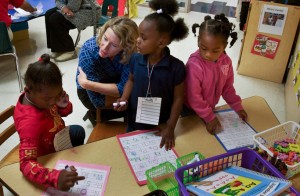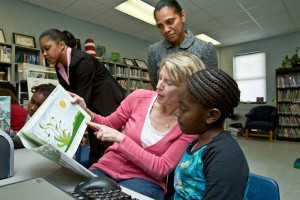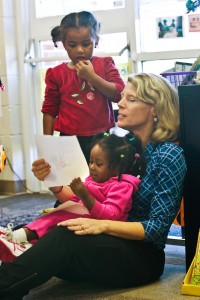I travel all over the world with Save the Children, but I spent time earlier this week visiting some of our most important efforts anywhere—those for kids right here at home. Poverty rates here in the United States are some of the worst we have seen in decades with nearly 1 in 4 kids living in poverty. And in areas like Clarendon County, South Carolina, where I visited this week, 38% of children live below the poverty line. In some counties we serve across the state, that number is more than 50%.
What’s the best way to change these statistics? Make sure that every child gets through the fourth grade learning to read. The data is clear: kids who can’t read at grade level by the time they leave elementary school have a very steep hill to climb. Many drop out in middle school and even more by high school. The poverty trap starts all over again when these kids drop out.
And the best way to make sure kids learn to read is to start early. Children living in poverty are already 18 months behind by age 4 in terms of developmental measures if they have no pre-school. Disadvantaged children who do not participate in early childhood education programs are 25% more likely to drop out of school. With early intervention, kids get an even shot at learning. That’s why Save the Children has started home visits with toddlers and moms as well as pre-school for 3- to 5-year-olds in many poor communities.
Those are the numbers but these are real kids—kids like William, a busy little 18-month-old I met in Summerton, S.C. He and his mother, Jessica, live in a small duplex in a government-subsidized housing complex. Jessica is determined to make sure she works with William to give him a head start. She meets every week with a Save the Children coordinator who helps her work with William on his motor skills and appropriate play activities to build his words and brain development.
 It’s also about adorable little girls like 4-year-old Hermione who attends the early childhood learning center, a clean, bright building with lots of toys and activities to keep Hermione and her classmates learning every day. I could tell after just a few minutes that Hermione is a bright kid—and with opportunities to learn and grow, she can learn to read on time and get through school with a better chance of success.
It’s also about adorable little girls like 4-year-old Hermione who attends the early childhood learning center, a clean, bright building with lots of toys and activities to keep Hermione and her classmates learning every day. I could tell after just a few minutes that Hermione is a bright kid—and with opportunities to learn and grow, she can learn to read on time and get through school with a better chance of success.
All of this takes a lot of dedicated people on the ground. An important part of the program is the Foster Grandparents program funded by the Corporation for National Service and coordinated by Save the Children staff. These dedicated “grannies and grandpas” come four days a week for four hours per day and work with kids in small groups to practice letters and numbers, colors and words.
This also all requires dedicated school staff and leaders. Leaders like Rosa Dingle, the local school principal who is invested in every child who walks through her door in the morning. Ms. Dingle is clearly a great combination of a tough administrator who runs a tight ship and a loving “extra mom” to every kid. Given the realities outside school, these young kids need every boost they can get.
 I left South Carolina in the warm sun that December day convinced more than ever that we need to redouble our efforts in the United States. We have an ambitious goal to expand our programs to all 50 states by 2015. The programs I witnessed in Clarendon County are making a real impact in the lives of children. As we continue and expand these programs, we can make a real difference and give kids living in poverty in the US a shot at a better life.
I left South Carolina in the warm sun that December day convinced more than ever that we need to redouble our efforts in the United States. We have an ambitious goal to expand our programs to all 50 states by 2015. The programs I witnessed in Clarendon County are making a real impact in the lives of children. As we continue and expand these programs, we can make a real difference and give kids living in poverty in the US a shot at a better life.
That’s a shot all kids deserve and one we need to make sure our own kids have too.


